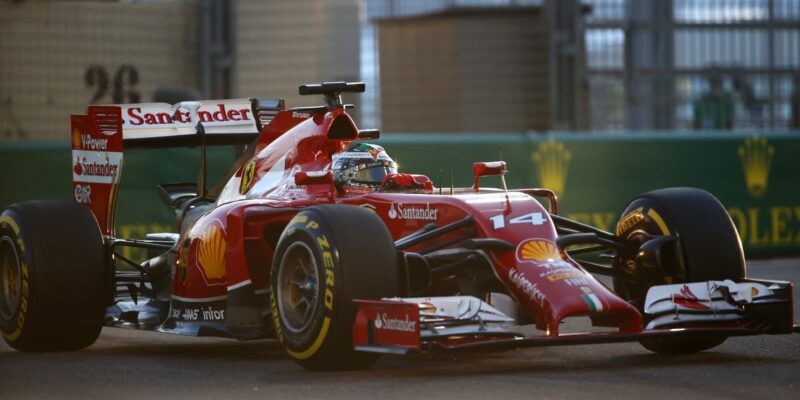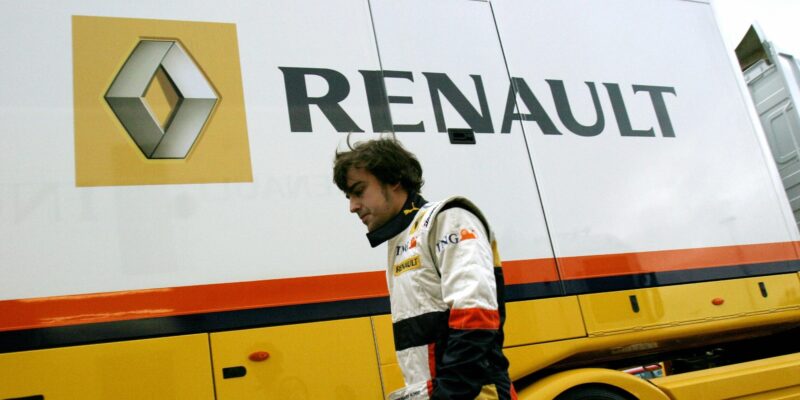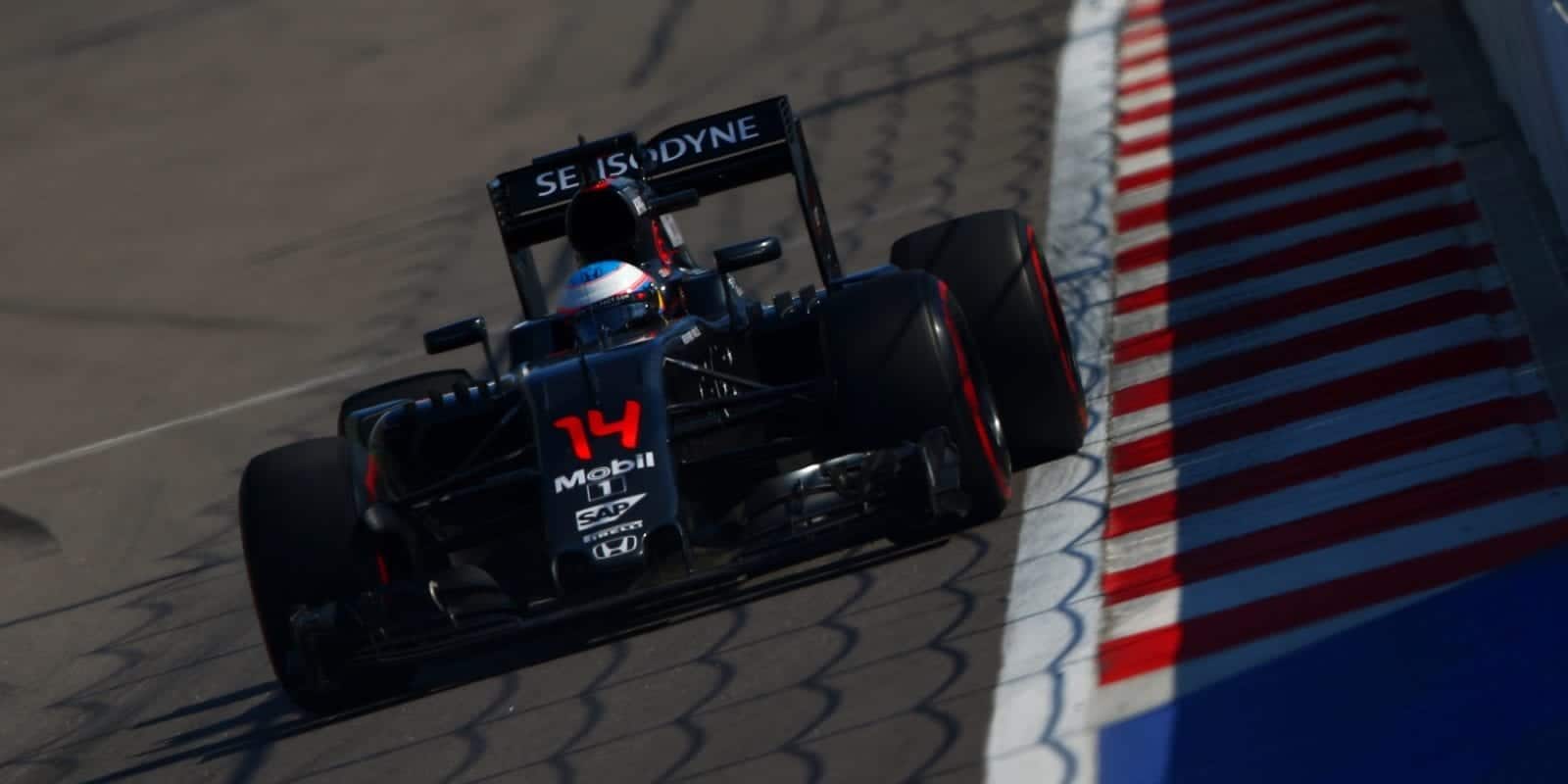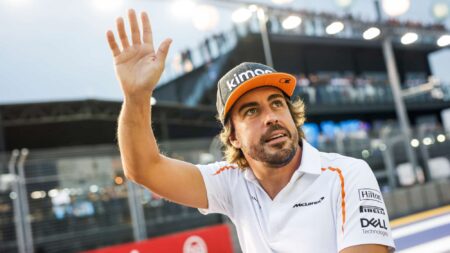Not even provisionally asking to be released from Ferrari, thereby triggering events that led to Sebastian Vettel taking his place there just as the James Allison-led technical group hit its stride? Maybe his recently discovered equilibrium just wasn’t conducive to the particular challenges of that role. “Not winning [the title] with Ferrari is quite stressing, because there are a lot of pressures when driving for Ferrari. After five years of not winning it, with still another two years of contract and not seeing the possibility of winning it within those two years… the prospect of being there seven years and not winning was not happy for me.” He and manager Flavio Briatore tried the obvious solutions – a place at Mercedes or Red Bull, a single-year contract with McLaren so as to be in a place to slot into one of those teams later, even just a single extra year at Ferrari – but there were roadblocks at every turn.
One inevitably wonders how significant it was that Briatore no longer operates within the F1 paddock, for he failed to find the crucial piece of knowledge in these negotiations: that Vettel had a clause in his Red Bull contract that potentially allowed him to be free one year early. “For Vettel, Ferrari is good,” Alonso says beatifically. “He is younger than me, at a different stage of his career. He’s young, motivated and the car can fight for podiums. But in the five years I did at Ferrari we twice arrived in the last race leading the championship – we were more than just contenders. So yes, Ferrari is much better now than in my final year there, but still I do not see an improvement from where we were for much of my time there. But Ferrari was magic and I take with me some very special memories.” Therapeutic rationalisation again? “I will always have Ferrari in my heart. I have its road cars in my garage, I have its cars in my museum and they are the cars people photograph most often.”
But the only championship trophies in his cabinet date from a decade or more ago. He won those titles by driving harder for longer than anyone else; his appetite for running lap after error-free lap on the ragged edge was insatiable, a fierce bundle of competitive energy that wore the opposition down. He did this in unusual rearward-heavy Renaults configured around the traits of the superb longitudinal grip of the Michelin tyres on which they ran, his almost brutally fast wrenching of the wheel into slow corners not pretty but devastatingly effective for this combination.
But all that stuff’s been neutralised for years; his biggest skill – that relentless ability to run flat-out – counts for nothing in the Pirelli control tyre age when the fastest way to finish the race is to drive slowly for most of it… So, with that skill redundant, is he now just another driver, no more effective than a dozen others?

The Alonso-Ferrari union never quite worked out despite coming very close
MARWAN NAAMANI/AFP via Getty Images
“No, absolutely not,” insists Joseph, who has worked since 2012 with Hamilton, Sergio Pérez, Kevin Magnussen and, for the past two seasons, Alonso. “It’s very clear he’s on a different level to the others I’ve worked with. That’s not putting the others down; it’s just his experience, awareness and ability to take on a lot of information, which is pretty incredible. We find ourselves at a level of discussion with him that we wouldn’t normally have with a driver – because he’ll start thinking about things that you imagine just engineers think about. He’s got so much experience he can think about other things, worry about the finer details. It’s really refreshing and it changes how you work.”
So, how does he go about still making the difference? “It’s definitely more difficult now,” Fernando says, “because in the new F1 it’s not necessarily the quickest way to push all the time because you will pay the price later in the lap or the stint, overheating everything. So sometimes to drive a bit more calm, a bit slower, will pay off at the end of the stint because the overall race time is quicker. It’s a little bit difficult but it’s still a challenge. As a driver you just try to keep improving and learn from everything, especially from the engineers and the team, because now the approach is different. But it’s the same for everybody. As long as there is competition in it. You’re still trying to maximise the package you have.
“It’s not pure driving. If you want that you need to go to karts – which I do. I push every lap, I spin the tyres and at the next corner I still have the same grip. I do one lap, 20 laps, 75 laps and in the same tenth, all of them. That’s pure driving. We don’t have that any more in F1. It’s less fun. But you arrive here, talk with your team, prepare with them in a different way. You still enjoy it, still have fun, try to learn, try to do something different compared with the other drivers – especially your team-mate – to take care of the tyres, the battery, fuel saving, all the different techniques in trying to be more efficient. Then there are the race starts, first laps, pitstops: a lot of tricky moments where you try to use all your experience to gain.”
Mark Temple is Alonso’s race engineer. Here’s how he sees it: “It’s about being able to extract the maximum all the time in a different way, thinking about the whole stint. ‘I know I’m going to do a longer stint than expected here so I need to manage my pace and tyres to achieve that’ – and that’s something he’s incredibly good at. He thinks a lot while driving about things other than that immediate lap. Often he’ll ask me stuff about the strategy that shows this very clearly. That amazing awareness is a strength he’s always had – that ability to drive very quickly with very few mistakes while also thinking about the whole race and managing it.” It strikes a very stark contrast with Hamilton, the one driver Alonso respects above all other rivals. Lewis needs the parameters imposed by the team to work within. Occasionally, he will override them, but only in the most blatant cases of the data not according with on-track reality. Alonso is an active participant in defining those parameters. Hamilton did intuitive things in the car that Alonso saw on the data traces in 2007, individual moments of virtuosity that confirmed to him Hamilton was a special case. But Hamilton’s big picture tends to have more missing pieces than Alonso’s. That’s certainly the view of Jenson Button who’s partnered both. “In many ways Fernando is an even tougher team-mate than Lewis was,” he says. “Yes, there were days when Lewis would just do something amazing, but there were other days when you got everything right when you wondered where he’d gone. With Fernando there are never any days like that. If he’s behind you he is pushing you like crazy.”
Temple adds: “Fernando has great adaptability in his driving style. The way he is able to adapt to a car or track or a tyre is very impressive. He will come back and say, ‘I think the problem is this,’ and you’ll look at the data and say, ‘I can’t really see that on the data,’ and it’s because he’s driving around it. So he’s driving around the limitation but it doesn’t mean it’s not a problem, just very difficult to see. And sometimes if you look at his first laps, where he hasn’t initially found the limit, that’s often when you see the problem manifest itself for the first time on the data. With him, it’s not just about the data, it’s often about the discussion of what the biggest problem is. Very much the big picture. That is where he is so outstanding.”

Can Alonso repeat his success with Renault in 2021?
CRISTINA QUICLER/AFP via Getty Images
Behind that, fortifying it, is belief, the total self-belief he’s always possessed. You may have heard him on TV saying to Martin Brundle: “I always feel confident about beating anyone. I don’t believe that I’m better than anyone on pure speed in qualifying, I don’t think I’m better than anyone in wet conditions, dry conditions, qualifying, race. But if you put me in the same car at the same moment and same track as anyone, I think that I will beat them. Maybe I’m not best of all sections, but overall I will beat them.” Not delivered in a boastful way, quietly, almost shyly. But with total conviction.
Temple largely agrees with that self-assessment. “The truly outstanding thing about him is being strong across all the areas. He is able to identify areas of weakness and really think about them, work on them and minimise them. It’s quite a conscious thing.” When he is slower than Button in qualifying, for example – as he was five times last year on the seven occasions in which a straight comparison was possible – it’s invariably because he’s gone over the limit of what’s required, not under. “It’s difficult to generalise,” says Temple, “because it varies with the circuit or the tyre or the type of corner, but Fernando is a driver who likes to be attacking and aggressive on corner entry and that’s one of his strengths. But it’s one of those situations where… with the very good drivers their strength is not necessarily a strength at every circuit. So being able to carry a lot of speed into corners and attacking on some circuits – like Singapore, where Fernando is super-strong – can be a massive performance advantage and at other circuits it’s not. It’s all about saying, ‘OK, don’t do that’, reining in the instinct.”
It isn’t that he is this all-conquering colossus in the mould of Senna or Clark, a driver that can seem to do everything better than all his rivals. He’s never been that. It’s more that he has a better set of averages.
And anyone who thinks the more accepting, serene Alonso has lost the desire or motivation need note only his response to Johnny Herbert’s pondering on that very subject, during the Bahrain Grand Prix, where Alonso made a point of interrupting Johnny’s live report to respond – in a not very delicate way. I ask him about this and it’s the most animated he is during the whole interview. “Yes, I felt a little lack of professional respect, but also it was because he questioned my motivation. On the very weekend that I was trying to get the FIA to allow me to race with cracked ribs and a pneumothorax! In 2014 with an uncompetitive car I scored triple the points of Kimi Räikkönen, in 2015 I was pushing the car in Hungary to the pitlane. So say I’m slow, ugly or whatever, but not that I’m not motivated. It makes no sense.”
And there is the complex competitive animal, the magnificent racing driver that is Fernando Alonso. Not quite the same Alonso as in his full glory, but no lesser than that either, just slightly different. Maybe he doesn’t have the all-round emotional intelligence of a Sebastian Vettel, that light touch that gets things exactly as he needs them without ruffling feathers. But he is what he is and surely still has within him some very special performances, whenever McLaren and Honda get their act together. If that doesn’t happen, then he has a plan. “I’d like to achieve the triple crown one day,” he says. “So Monaco Grand Prix, which I have won already, then the Indy 500 and Le Mans 24 Hours. It’s a big challenge and if I’m happy and motivated still, maybe that can be my challenge.”


